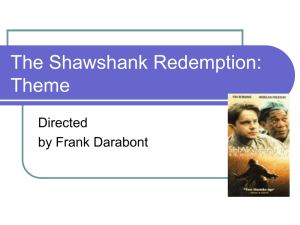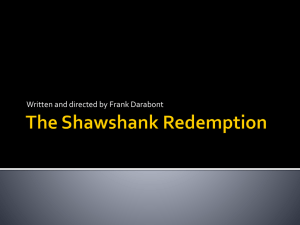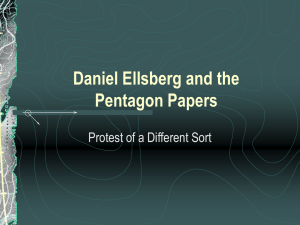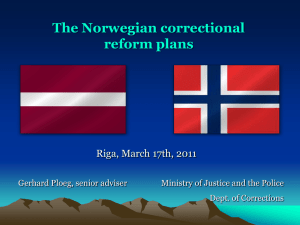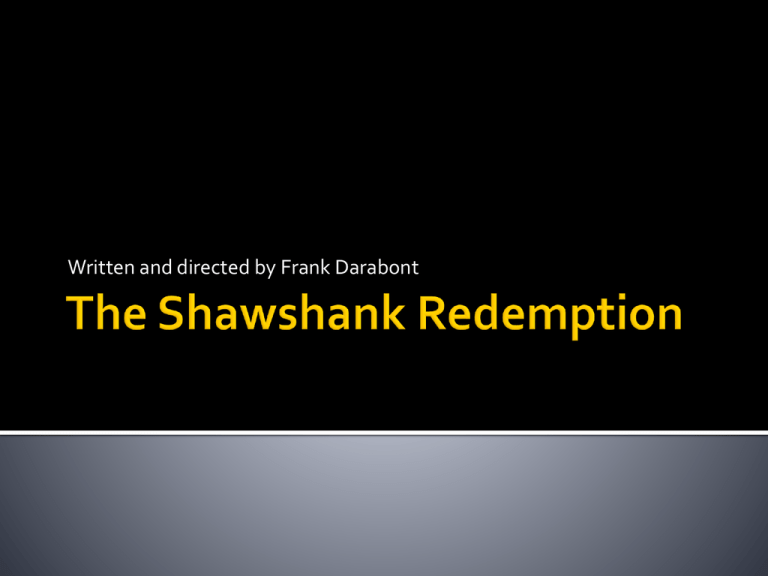
Written and directed by Frank Darabont
Analyse film image and sequence in detail
Understand the way film language creates
setting and character, and manipulates our
responses
Describe how verbal and visual features are
combined for different purposes
Respond to and interpret meaning, ideas and
effects
Write an essay about an aspect of the text
In 1946, a banker named Andy (Tim_Robbins) is convicted of a double murder, even
though he stubbornly proclaims his innocence. He's sentenced to a life term at the
Shawshank State Prison in Maine, where another lifer, Ellis "Red" Redding
(Morgan_Freeman), picks him as the new recruit most likely to crack under the
pressure. The ugly realities of prison life are quickly introduced to Andy: a corrupt
warden, sadistic guards led by Capt. Byron Hadley, and inmates who are little better
than animals, willing to use rape or beatings to insure their dominance. But Andy
does not crack: he has the hope of the truly innocent, which (together with his
smarts) allow him to prevail behind bars. He uses his banking skills to win favour with
the warden and the guards, doing the books for Norton's illegal business schemes
and keeping an eye on the investments of most of the prison staff. In exchange, he is
able to improve the prison library and bring some dignity and respect back to many
of the inmates, including Red.
The Power of Hope: drive the inmates and gives them the will to live.
Andy’s drive to maintain his own sense of self-worth and freedom is
what prevents him from dying of frustration in solitary confinement.
Institutionalization: to become a part of a well organized system and
follow a routine. It aims at integrating fundamental values and
controlling the behaviour and conduct of those institutionalized.
When the inmates are released after years of being suck in
Shawshank, they find difficulty functioning in the real world, this is
the effects of Institutionalization. The inmates follow a set routine
and don’t make any of their own choices in life. After so long of not
being able to make their own decisions, the inmates can start to lose
their independent decision making skills.
It represents freedom outside the walls of the prison, it represents
intellectual freedom.
Andy transforms it from Brooks’ private domain to a public one,
symbolising freedom and democracy, the very opposite of prison.
Prison has Andy’s body, but he wont let it take his mind.
The prison becomes Andy’s office, where he does taxes for the guards
and is a communal meeting space.
The library serves as a turning point in the novel: while building up the
library, Andy tries to play by the rules and works within the system as a
“legitimate inmate”, but after Tommy is killed, Andy realises he must
think like a criminal in order to implicate the warden and escape.
Andy plays the duet from the Mozart’s album, it is timeless and a
universal thing of beauty.
The inmates don’t understand a word of it, but everyone stops working
and talking in the yard. Everyone is frozen.
It reminds them of marriage, love, women and freedom, all that is not
Shawshank.
Andy is a martyr here for art. He is willing to punish himself to let
freedom ring.
What is another scene that is similar to this one?
The scene where he arranges the bottles of suds for the guys while tarring
the roof. Both these scenes make Andy and the inmates feel human again.
Shawshank has their bodies but it does not have their souls.
There are many controversial issues dealt with in this film. These range
from abuse of prisoners to loyalty and friendship. The following is a list of
some of the most important themes touched on in the movie.
Courage
Loyalty
The power of the mind vs. the power of authority
Institutionalisation
Corruption
Justice/injustice
Freedom
1.
2.
3.
4.
5.
1.
2.
3.
4.
5.
Themes
Importance of hope
Justice/injustice
Corruption/abuse of power
Friendship
Institutionalisation
Characters
Andy
Red
Tommy
Warden Norton
Captain Hadley
Explain the meaning of institutionalised. How does it apply to Brooks?
What aspect(s) of prison life are emphasised throughout the movie? Give
examples.
Why does the Pacific Ocean have such appeal to Andy?
How do all the prisoners accept one another’s crimes in the prison? How is
this significant?
List some examples of corruption of the legal process and the corrections
process in the movie.
In what respects is justice finally achieved in the movie? Comment.
Themes and issues (activity).
A range of techniques are used to develop Andy’s character. Complete
the hand out, discussing what each of these techniques tells us about
Andy.
Opening scene notes
Opening scene close viewing analysis.
1 . Extreme long shot
This can be taken from as much as a quarter of a mile away, and is generally
used as a scene-setting, establishing shot. It normally shows an EXTERIOR,
eg the outside of a building, or a landscape, and is often used to show
scenes of thrilling action eg in a war film or disaster movie. There will be very
little detail visible in the shot, it's meant to give a general impression rather
than specific information.
This is the most difficult to categorise precisely, but is generally one which
shows the image as approximately "life" size ie corresponding to the real
distance between the audience and the screen in a cinema (the figure of a
man would appear as six feet tall). This category includes the FULL SHOT
showing the entire human body, with the head near the top of the frame
and the feet near the bottom. While the focus is on characters, plenty of
background detail still emerges: we can tell the coffins on the right are in a
Western-style setting, for instance. A long shot is used to stress the
environment or setting of a scene.
Contains a figure from the knees/waist up and is normally used for dialogue scenes, or to
show some detail of action. Variations on this include the TWO SHOT (containing two
figures from the waist up) and the THREE SHOT (contains 3 figures...). NB. Any more than
three figures and the shot tends to become a long shot. Background detail is minimal,
probably because location has been established earlier in the scene - the audience already
know where they are and now want to focus on dialogue and character interaction. Another
variation in this category is the OVER-THE-SHOULDER-SHOT, which positions the camera
behind one figure, revealing the other figure, and part of the first figure's back, head and
shoulder.
This shows very little background, and concentrates on either a face, or a specific detail of
the scene. Everything else is just a blur in the background. This shot magnifies the object
(think of how big it looks on a cinema screen) and shows the importance of things, be it
words written on paper, or the expression on someone's face. The close-up takes us into the
mind of a character. In reality, we only let people that we really trust get THAT close to our
face - mothers, children and lovers, usually - so a close up of a face is a very intimate shot. A
film-maker may use this to make us feel extra comfortable or extremely uncomfortable
about a character, and usually uses a zoom lens in order to get the required framing.
As its name suggests, an extreme version of the close up, generally magnifying beyond
what the human eye would experience in reality. An extreme close-up of a face, for
instance, would show only the mouth or eyes, with no background detail whatsoever. This
is a very artificial shot, and can be used for dramatic effect.
A camera angle that looks down upon a subject. A character shot with a
high angle will look vulnerable or small. These angles are often used to
demonstrate to the audience a perspective of a particular character.
a camera angle that looks up at a character. This is the opposite of a high angle and makes
a character look more powerful. This can make the audience feel vulnerable and small by
looking up at the character. This can help the responder feel empathy if they are viewing
the frame from another character's point of view.
puts the audience on an equal footing with the character/s. This is the most
commonly used angle in most films as it allows the viewers to feel comfortable
with the characters.
This term (which loosely means 'putting things in the picture' or
'arranging the frame') concerns the design and arrangement of the
image. Every element of an image contributes to its meaning, and much
time and thought is devoted to mise en scène by the creators of an
image. Although an audience's attention may be focused on characters in
the foreground, they will also be looking at the background for additional
clues to meaning. For example, two characters having an argument in a
softly lit bedroom, with many pillows, pastel colours, throw rugs, and
Martha Stewart style room accessories are not seen to be as dangerously
conflicting as two characters arguing in a deserted warehouse, under a
naked light bulb, surrounded by the jagged angles of torn-apart packing
crates, with concrete, not deep-pile carpet under their feet.
Mise-en-scène includes costumes, props, lighting, characters (as
represented by actors or models), special effects, sound effects and
anything else which is "put into the frame". The level of a image's realism
relies heavily on mise en scène.
The composition of an image is simply what it is made up of. An image
will display a series of objects or people, and when referring to its
composition we look at their arrangement within the picture. Often we
infer meaning through two objects relationship with each other. Is one
depicted as larger? More central? Better lit? How much space is there
surrounding the objects?
Apart from arranging objects within the picture, another decision that is
made in composition is focus, or depth of field. This dictates the depth
into the picture in which objects are in clear focus. You may becide to blur
out the background, in order to place more emphasis on central or
foreground objects. or you may decide to have everything in your picture
in equal focus, for instance in a landscape shot, or a group photo.
Framing —deciding where an image begins and ends — is as vital to the
meaning of an image as composition. There are a whole variety of
camera angles which can be selected to frame a shot (see left button
bar), and often what is left out is as important as what is included. What
is beyond the picture, for instance, what could a model be looking at, is
the source of much ambiguity and enigma. We infer meaning from the
relationship between the camera and subject (a close up is intimate,
By framing two objects together in the same image, we imply a
connection between them, especially if there is a physical link, perhaps
through a graphic or colour, between them. If the connection is unusual
(juxtaposition), we are forced to consider it more carefully and this may
alter our reading
By isolating an object within the frame - for instance showing a swimmer
against an expanse of nothing but sea - we can make them seem
insignificant and lonely. Are characters surrounded by others (trapped?
loved?) or do they have space (power? insecurity?). Are they where they
need to be.
Lighting is part of the mise-en-scene, and is one of the deliberate choices made. The use of
natural or artificial light can change the composition of a shot. Lighting is a very important
aspect for shaping meaning in films. What kind of atmosphere is created in a room lit by
candles? Have you ever heard of mood lighting? A room that is brightly lit by neon lights
might seem to be sterile or a shadowy room might be eerie or scary. The lighting
technicians in a film crew have the task of creating lighting to suit the mood and
atmosphere of each scene in a film.
Andy’s ambivalence
Sound track song reflects Andy’s mood of disillusion and fatalism.
Car and clothes suggest 1946. Red later says that “Andy came to Shawshank
prison in 1947 for murdering his wife and the fella she was banging.”
Andy is depressed because of the failure of his marriage, but the film gains a
lot of its appeal by not telling us things such as this for some time. As with
the poster of Rita Hayworth.
Immediately, therefore, suspense is a hallmark of this thriller.
The darkness mirrors his mood. The shattering of the bottle= the shattering
of his dreams.
The trail
CUT and AURAL BRIDGE to the courtroom without completing the previous
action, leaving us suspended in mid-plot- the scene outside the cabin is
intercut with the trail scene.
Having found out about the affair, Andy angrily refused to give her a
divorce an Reno, Nevada.
V.O from the trail melds the three scenes together: the two having
steamy sex, Andy pondering in the car and the courtroom: smooth
CROSS-CUTTING giving variety in story telling.
Andy claims to have thrown the gun into the Royal River on his way
home- “I feel I have been very clear on this point”
LOW ANGLE CU of the prosecutor, raised voice and leaning forward,
accentuating his menace.
Throughout a piano tinkles with suspenseful strings, heightening the
tension.
CU LOW ANGLE of judge heightens .his forbidding demeanour; his
words come slowly and precisely: “you strike me as a particularly icy and
remorseless man, Mr Dufrensne. It chills my blood just to look at you.”
HIGH ANGLE CLOSE on Andy , stressing his helplessness before the
power of the law. “By the power invested in me by the state of Maine, I
hereby order you to serve two life sentences back to back, one for each
of your victims. So be it!”
His gavel thumps down in symbolic representation of the law’s awesome
force, Andy closes his eyes in hopeless resignation and the screen goes
black, representing the awful fate that awaits him.
The audience is left deliberately in the dark re Andy’s guilt; indeed, we
probably share the judge’s distaste for this seemingly cold, unemotional
man. A PAN across the jurors suggests they do too.
Analysis = what + how + why
What = details, film techniques, features
How = effect; how they communicate or contribute to viewers’ understanding of ideas
(theme, character, setting, whatever the question is asking)
Why has this technique been used
E.g. Darabont uses the harmonica as a symbol of hope. Andy gives the harmonica to Red,
representing the hope and inner strength he is helping Red to find. It helps s to
understand that our friends can aid us in holding on to our self-belief, even in times of
struggle, like Red’s long prison sentence. When Red blows it we know Andy is helping him
hold on to whatever hope he has left. As Andy’s gift to Red, the harmonica is a clear
development of the symbolism established in the aria scene. Here Andy plays The
Marriage of Figaro over the prison intercom, when “for a moment, every last man in
Shawshank felt free”. Here the power of music represents the power of the individual to
inspire. We see the same inspiration when Red, framed in a tight close-up in his cell in
Shawshank’s inly blackness, holds the gleaming harmonica in his hands. We desperately
want him to play it- he “played a mean harmonica once’- and the single, forlorn note he
blows shows us just how close Shawshank has come to breaking his spirit.
Task
In groups you will write an analysis of the opening scene. While watching the
scene take notes on the following:
1.
What information is given to the audience
2. What characters do and say
3.
What production techniques are used (music, camera work, lighting,
symbols, colours, costumes etc.)
4. Darabont’s purpose ( what he wants us to think/feel about the themes
and story).
Institutionalisation
Red steps into the prison yard and we got our first look at Shawshank prison.
Grey walls.
“How did it go?” asks one inmate.
“Same ol’ shit, different day.”
“I’m up for rejection next week.”
Red begins the V.O narration that anchors the film. He is the prison’s
respected retriever.
Prison sirens blast as a ritualistic prison event is heralded – the arrival of
fresh, new prisoners in a drab-grey school bus.
An aerial (helicopter) shot moves up from the arriving bus, ascends the main
tower of the prison and peers down into the prison courtyard where ant-like
prisoners swarm towards the main gate to gawk and jeer while the new
arrivals (fresh meat) disembark.
A sweeping helicopter travelling shot of the approach to the prison and the prison
yard behind reveals the massive Gothic Victorian towers and high walls, the immense
area of the compound, in comparison with which humans are puny and insignificant.
This shot is highly symbolic, reflecting how it is impossible to escape, how crushing
the system is. The system is awesome and forbidding.
Cellos and violas reinforce the sombre atmosphere.
Subsequent shots emphasise the intimidating nature of the surround- steel mesh
fencing, grey walls, a bleak sky, ruthless guards, gates guarded, tight security, guards
up high with machine guns- while in contrast, green fields and trees lie beyond.
Jeering inmates rattle the steel mesh fencing like caged animals in the zoo. They are
beasts.
Captain Hadley eyeballs every prisoner as they step off the bus, chained to each other.
The crude prison vocabulary makes the scene more authentic, suggests the brutality
and inhumanity prisoners show to each other and makes for an original, fine script.
“I didn’t think much of Andy the first time I set eyes on him. Looked like a
stiff breeze would blow him over. That was my first impression.”
Statement implies that something will happen to change Red’s opinion, so
creating tension.
Andy looks up and the camera is his eyes: A POV< LOW ANGLE SHOT.
The enormity of the walls is emphasised and only a small patch of sky can
be seen, which is grey. Strong feeling of entrapment.
The main characters are quickly characterised: Heywood his a slight
stammer and sweeping blonde hair. Hadley looks as if he would be at
home in a Nazi concentration camp.
Task
The following analysis was taken from an essay that achieved Merit. Compare this with
your analysis.
1.
How could you improve your analysis? (improve it)
2.
How could you improve the Merit to an Excellence.
The prison itself helps to develop the theme of how important hope and determination is.
We are first introduced to the prison at the beginning of the film by a very imposing
helicopter shot rising up and over the prison. Darabont has used this camera shot to show
how large and imposing the prison walls are. Another camera shot used by Darabont to
show how imposing the prison is when Andy is entering the prison. A low angle nearly
vertical tilt up shot is used. This shot also shows how large and imposing the prison is. Due
to the audience being introduced to the prison in this way, it seems as though the theme
of hope and determination would not survive within the thick and tall standing walls. But
Darabont has purposely used the prison described by him as a “main character” as he
wants to show the audience how easy it would be to lose this hope and determination.
The prison is made from stone called granite. This gives the prison a very cold and sad
feeling. It also seems as though it is a very strong place, impossible to break out of. This
would only be true if the theme of hope and determination died.
After two years of imprisonment, the worst in Red’s memory for Andy,
Red and Andy are selected from volunteers to begin a week’s work to
resurface the roof of the licence plate factory.
In the fresh air of the outdoors-without walls, fences, or bars- while the
cons pour and spread tar on the roof, Captain Hadley complains bitterly
about the government taxes that he will owe after receiving an
inheritance from his rich brother’s estate. Hadley has been left $35000,
and most of that will go in tax.
“ Uncle Sam, he puts his hand in your shirt and squeezes your tit till it’s
purple.”
Andy overhears and asks the Captain, “Mr Hadley, do you trust your
wife?” furious with his audacity, Hadley grabs Andy and jerks him
towards the edge of the roof to throw him off.
Andy quickly explains how he can keep the $35000, through gifting it to
his spouse.
For his part of the bargain, Andy requests “three beers apiece for each of
my co-workers …I think a man working outdoors feels more like a man if
he can have a bottle of suds. That’s only my opinion.”
Pay attention to Red’s Voice Over in this scene.
“We sat and drank with the sun on our shoulders and felt like free men.
Hell, we could have been tarring the roof of one of our own houses. We
were the lords of all creation… Me, I think he did it just to feel normal
again, if only for a short while.”
One of the guards expresses his sorrow at the death of Hadley’s brother,
but Hadley responds, “I’m not, he was an asshole.”
Effective overhead shot shows Andy precariously balanced, with people
beneath seeming minuscule. The tension is high; Andy is close to death.
Track to level MS of Andy over Hadley’s shoulder.
Blue sky, green fields and trees can be seen- things are looking better for
him.
Immediate sudden CUT to beer being swilled. “And that’s how it came to
pass.”
The biblical language used strengthens the feeling that we are witnessing
the rebirth of a people via prophet Andy, who has come to show them the
way to rise above their sinful world.
Why do you think Andy doesn’t drink or sit with the other prisoners?
What does this symbolise?
“You’re that smart banker what killed his wife, aren’t ya?”
“I’m not, he was an asshole.”
After six years of request letters, boxes of books are delivered to the
supervisor’s office accompanied by a cheque for $200 from the State
Controller’s office. Andy finds a box set of Mozart’s opera The Marriage of
Figaro. In another redemptive act similar to the one on the rooftop, he
places the record on a phonograph player in the office, locks the doors
and broadcasts the opera on the P.A system throughout the entire prison
to share a moment of freedom and make the prison walls dissolve.
Guards in a bunkhouse and prisoners on the open yard are stunned and
hypnotised by the music as it floats from the loud speakers over them
and breaks the routine of prison life. The music transcends the day-today numbness. Andy reclines back in his chair, with his arms on the back
of his head and a sublime smile on his face, ecstatically experiencing the
music and dreaming of freedom.
VO: I have no idea to this day what those two Italian ladies were singin’
about. Truth is, I don’t want to know. Some things are best left unsaid. I
like to think they were singin’ about something so beautiful it can’t be
expressed in words and makes your heart ache because of it. I tell you
those voices soared. Higher and father than anybody in a grey places
dares to dream. It was like some beautiful bird flapped into our drab little
cage and made those walls dissolve away. And for the briefest of
moments, every last man in Shawshank felt free.
Andy increases the volume rather than turning it off- the Warden
punishes Andy with “two weeks in the hole for that little stunt.” Andy is
not phased by the harsh consequence as the music freed his soul, but
Red is fearful of becoming to hopeful:
Andy, “I had Mr Mozart to keep me company. (He points to his head) it was in
here. (And he gestures over his heart) And in here. That’s the beauty of
music. They can’t get that from you. Haven’t you ever felt that way about
music?... Here’s where it makes the most sense. We need it so we don’t
forget… that there are places in the world that aren’t made out of stone, that
there’s, there’s something inside that they can’t get to, that they can’t touch.
It’s yours.”
Red, “What are you talking about?”
Andy, “Hope.”
Red, “let me tell you something, my friend. Hope is a dangerous thing. Hope
can drive a man insane. It’s got no use on the inside. Better get used to that
idea.
Andy, “Like Brooks did?”
Wiley, “Good for you, Andy.”
Shows there is some humanity in some of the guards.
“It only took six years”, Andy jokes. Andy is going to write two a week from
now on!
Reveal about his character?
He is persistent.
A lovely contrast: Wiley sits in the toilet reading a joghead comic, while
Andy finds a boxed set of Mozart’s The Marriage of Figaro. What does this
show?
The difference in education, intelligence and refinement!
The music is beautiful and uplifting, the antithesis of prison life. Women have arrived in
Shawshank!
The voices soar over the whole compound. We see men in the infirmary get out of bed to
look outside, Wiley pulls his pants up abruptly; men in the wood shop stop their work.
Everyone is transfixed.
An effective lifting crane shot gives a bird’s eye view of everyone stock till. The shot
symbolises the soaring of the prisoners’ spirits.
Another effective shot follows the electrical cord from the player to Andy, reclining with his
hand behind his head in an armchair.
We see an alternative to the brutal “rehabilitation” offered at Shawshank.
Red use to “play a mean harmonica” in the outside. “Lost interest in it though.” Here “it
didn’t seem to make much sense.”
Alternating over the shoulder shots bind the two together. “Here’s where it makes the most
sense,” replies Andy.
Red has given up hope: “let me tell you something, my friend. Hope is a dangerous thing.”
Solemn , slow horns and strings play mournfully, reflecting Red’s mood. He clashes down his
cutlery in frustration- he’s not getting through to Andy.
Brooks goes berserk when his parole comes through- he holds a knife at
Heywood’s throat so he’ll be judged crazy and not be released into the
frightening real world. “I got no choice… It’s the only, it’s the only way
they’d let me stay.”
VO: He’s just institutionalised… The man’s been here for fifty years,
Heywood, fifty years. This is all he knows. In here, he’s an important man;
he’s an educated man. Outside he’s nothing- just a used up con with
arthritis in both hands. Probably couldn’t get a library card if he tried…
These walls are funny. First you hate ‘em, then you get used to ‘em.
Enough time passes, it gets so you depend on ‘em. That’s
institutionalised… They send you here for life and that’s exactly what
they take- the part that counts anyway.
Just before he departs the prison the next dawn, Brooks also releases his fullgrown pet crow Jake at the library window; “I can’t take care of you no more,
Jake. You go on now. You’re free.” The bird is a parallel to the man. The old
con steps cautiously through the main gate of Shawshank, clutches the bar
on the bus seat in front of him as he is transported to Portland where it is
even terrifying to cross the street:
Brooks “Dear Fellas,
I can’t believe how fast things move on the outside. I saw an automobile once
when I was a kid but now they’re everywhere. The world went and got itself in a
big damn hurry.”
He is placed in a halfway flop house called the Brewer, and is employed as a
grocery-bagger at the Foodway market. Lonely, afraid, melancholy and
disorientated in the outside world, he has difficulty sleeping. He worries about
the fate of Jake as he feeds pigeons in the park. He even contemplates shooting
the Foodway manager- “So they can send me home.”
He climbs up onto the table and then onto a chair and carves a message into the wall with
his pocket knife, “BROOKS WAS HERE.” And then he kicks out the chair from underneath
his weight and hangs himself- his feet dangling. The end of Brook’s letter is read out loud
by Andy in the prison yard following his death. “He should have died in here,” is Red’s
epitaph.
He sets Jake free in the dark, what does this reflect?
Will the bird be able to survive without his faithful friend?
The bird is free at last, but his colour is black.
The camera MS ZOOMS in on Brooks in the bus, gripping the bar of the seat in front. What
does this symbolise?
“I’ve decided not to stay” how are these words deliberately misleading?
How does the film mislead us again?
The table is kicked away and Brooks leaves this world, hanging himself- unexpected, as we
have been given no clues how he will do it.
what is the other purpose of the sequence, apart from showing the effect of long-term
incarceration?
Foreshadows Red’s difficulties when he is finally released.
Andy squeezes through the tight tunnel shaft. When he emerges through the wall, he
times his attack on the sewer pipe with the crashes of thunder; then inches his way
head-first through the raw sewages passage:
V.O. Andy crawled to freedom through 500 yards of shit-smelling foulness I can’t even
imagine. Or maybe I just don’t want to. Five hundred yards. That’s the length of five
football fields, just shy of half a mile.
He emerges from the dark tube and lands in the waist-deep creek filled with cleansing
water. In the film’s most familiar image, Andy strips off his prison shirt and T-shirt in
the middle of the creek and extends his arms up from his half-naked body to the skyvictorious and liberates. The camera pulls back from overhead as the rain washes
down on him in droplets.
The next morning while his escape is being discovered, the camera follows and
anonymous man’s shiny black shoes as he enters the Maine National Bank in
Portland: “Until that moment, he didn’t exist-except on paper.” He had “all the proper
ID”- identified as the ‘phantom’ Randall Stevens- when he withdrew and closed all his
accounts. A final request is made to add a package to the bank’s outgoing mail.
The package is delivered to the offices of the Portland Daily Bugle. The
day’s newspaper- which figuratively and literally blows the bugle of
judgement on the warden- is tossed down on Norton’s desk as he reads
it- with the scandalous headline, “Corruption, murder at ShawshankD.A. has ledger-indictments expected.”
Police sirens sound in the distance as they approach the prison. Norton
glances at the needle-point- now read as prophetic: “His judgement
cometh and That right soon’ and opens the safe, finding Andy’s blackcovered Bible, the warden’s gift, instead of the black ledger with
evidence of evil doing. The inside cover is inscribed with Andy’s
handwriting : Dear Warden, you were right. Salvation lay within. Andy
Dufresne.
Andy is metaphorically reborn as he emerges from the dark tube (birth
canal). The waist deep creek filled with cleansing water=baptism.
Effective longshot of a floodlit prison, panning down to show him
emerging from the pipe into the creek, so emphasising the distance.
Rain pours down on him, washing him clean. He is laughing. The
orchestra has built up to a resounding crescendo during the escape.
A brief CUT repeats Norton looking down the tunnel.
MONTAGE of police arrival, arrest, heightening tension. A repeat shot of
four police cars speeding towards the prison. Hadley is handcuffed.
Norton observes this from his office upstairs; he pulls open a drawer to
reveal a gun=OUTPOINT
Make sure you establish your argument or case at the beginning of your analysis.
Change the following ideas into arguments you could base your essay around:
1.
2.
3.
4.
Institutionalisation
Hope
Dehumanisation
Rehabilitation
Try starting your paragraphs by acknowledging the Director’s intentions and reinforcing your
argument.
E.G. Darabont utilises a variety of film techniques to illustrate how institutionalisation prevents
men from functioning outside of prison.
Make sure you are always attacking the question and reinforcing your argument.
E.G. Darabont uses dialogue in Brook’s release scene to emphasise how dependent prisoners
become on the strict routine of prison life and their inability to cope outside the great walls of
Shawshank.
Avoid re-telling to much plot. Only include the necessary information.
Comment on the effectiveness of these film techniques. How did they
give you a greater understanding of characters or themes?
Draw some conclusions from the text.
E.g. Brook’s failure to adapt to a life outside of prison and eventual suicide
reveals how easily we can be manipulated by our environment. The
suppressive system of Shawshank illustrates the fragility of the human mind
and our tendency to be controlled by our insecurities.

